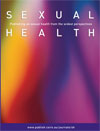
Sexual Health
Volume 15 Number 3 2018
SHv15n3_MeetEDMeet the Editors
SH17046Sexual transmission of Zika virus: a literature review
The extent of the effect of sexual transmission on the spread of Zika virus around the world is not well-characterised, but has particular relevance to travellers to and from non-endemic regions, and assisted reproduction services.
SH17108Sexual (dys)functioning is related to drive for thinness, not drive for muscularity
Body image problems can impact one’s performance and enjoyment in the bedroom for both genders. This paper examines which body image factors predict these problems, and found that wanting to be thinner was the main cause of dysfunction. This highlights how the promotion of thinness can have far-reaching consequences, affecting not only how we feel about ourselves, but also our interactions and relationships with others.
SH17017Sexual content in video games: an analysis of the Entertainment Software Rating Board classification from 1994 to 2013
Video games are a source of exposure to sexual content for children and adolescents. We aimed to analyse the trends of sexual content in video games from 1994 to 2013. Our results suggest that sexual content in video games has increased for ratings ‘Teen’ and ‘Mature’. Top selling video games had more sexual content compared to non-top selling games.
SH17111Concordance between monetary and sexual delay discounting in men who have sex with men
Delay discounting is a measure of impulsivity, often measured in the context of financial choices, that is associated with multiple health outcomes and might be associated with sexual risk-taking. The current study assessed the concordance between monetary and sexual discount rates. No association was observed between monetary and sexual discount rates suggesting that these are distinct processes.
SH17074Age differences in attitudes toward safer sex practices in heterosexual men using an Australian Internet dating service
STIs are increasing in older people globally. This cross-sectional study investigated STI knowledge, safe sex attitudes and behaviours of heterosexual men using an internet dating service. Results suggested that older men had lower STI knowledge scores, lower use of condoms and greater beliefs that condoms reduced interest in sex. Health promotion interventions to increase STI awareness, condom use and STI testing in older men are warranted.
SH17110Diagnosis of Chlamydia trachomatis, Neisseria gonorrhoeae, Trichomonas vaginalis and Mycoplasma genitalium: an observational study of testing patterns, prevalence and co-infection rates in northern New Zealand
We studied community prevalence and testing patterns for sexually transmitted infections in northern New Zealand. After Chlamydia trachomatis, Mycoplasma genitalium was the most common infection detected, though it is not routinely sought. There was a mismatch between testing rates and prevalence of infection in high risk patient groups. We conclude that testing strategies should be altered to better reflect need.
SH17097Leveraging a relationship-based sexual health framework for sexual risk prevention in adolescent men in the United States
Relationships are an important venue for sexual risk prevention. The current study links a collection of positive sexual attributes in relationships, such as communication and sexual satisfaction, to lower sexual risk behaviours, such as condom use and intimate partner violence, in adolescent men. These findings suggest that helping young men build positive relationships may also help them avoid sexual risk.
SH17137HIV susceptibility among clients of female sex workers in Indonesia: a qualitative inquiry
The Clients of female sex workers (FSWs) in Belu and Malaka districts of Indonesia are a group at higher risk for HIV transmission due to their frequent engagement in sex with multiple female sex workers (FSWs). This study aimed to identify risk factors for acquiring HIV infections among them and found several behavioural and socioeconomic factors that increased their susceptibility to these infections. These findings provide information about HIV susceptibility factors among FSWs’ clients, which can be used to develop programs and policies to help the study participants.
SH16218Using marijuana, drinking alcohol or a combination of both: the association of marijuana, alcohol and sexual risk behaviour among adolescents
There is currently little understanding of whether marijuana use alone or combining marijuana with alcohol use contributes to sexual risk behaviour among adolescents. This study aimed to assess the association between use of marijuana, alcohol, and sexual risk behaviour among adolescents and found that combined alcohol and marijuana use or alcohol use alone was associated with greater sexual risk behaviour. Providers should screen and educate adolescents about these risks.
SH17118The development of an online risk calculator for the prediction of future syphilis among a high-risk cohort of men who have sex with men and transgender women in Lima, Peru
The incidence of syphilis has been on the rise since the early 2000s. We aimed to identify factors which might predict future syphilis among high-risk populations and developed an online risk calculator for future infection. The ability to predict future syphilis may inform screening recommendations and other prevention strategies.
SH17154Risky business: is pubic hair removal by women associated with body image and sexual health?
Pubic hair removal, while linked to physical health concerns, may also be part of a more global pattern of appearance dissatisfaction and risky sexual behaviour. This study shows that women with greater appearance concerns and sexual health indicators remove a larger amount of pubic hair and report more reasons for pubic hair removal. Thus, women who report more pubic hair removal may endorse a broader array of risky beliefs and behaviours that can compromise both their physical and psychological well-being.
SH17064Comparing Australian gay and bisexual men with undiagnosed and recently diagnosed HIV infection to those in the National HIV Registry
Studies of recent seroconverters provide key insights for HIV-prevention. We sought to identify how representative of all recently diagnosed gay and bisexual men in Australia were those included in three study samples. Although undiagnosed men were somewhat younger, the study samples were broadly similar to all gay and bisexual men recently diagnosed with HIV, suggesting that these research approaches were reasonably effective."


